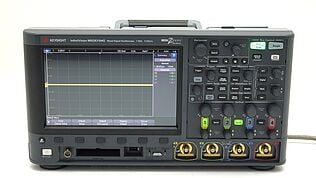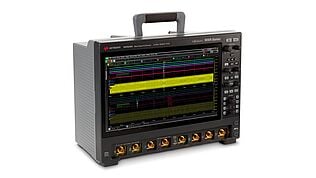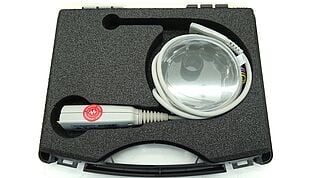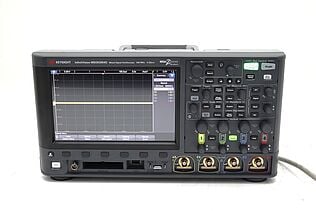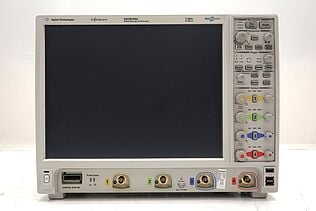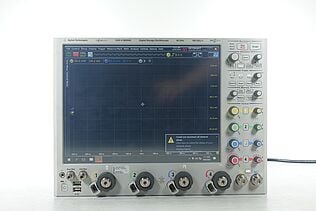- Introduction
- Understanding Mini Oscilloscopes: Fundamentals and Functions
- How Does a Mini Oscilloscope Work?
- Browse Our Latest Deals of Used Oscilloscopes
- Tapping Into the Potential of Mini Oscilloscopes
- Discerning the Ideal Use Cases for Mini Oscilloscopes
- Weighing the Strengths and Limitations of Mini Oscilloscopes
- Tips for Maximizing the Use of Mini Oscilloscopes
- Effective Use of Triggering
- Optimize the Sampling Rate
- Mastering Waveform Interpretation
- Conclusion
- Whenever You’re Ready, Here Are 5 Ways We Can Help You
- Browse Our Deals of Used Oscilloscopes With Biggest Savings
Isn't it incredible that a device that fits into your pocket can accurately display and scrutinize complex electrical signals, often rivaling the capabilities of its larger counterparts? Welcome to the world of mini oscilloscopes, the tiny titans of signal analysis that have elegantly redefined the norms of electronic testing. They are indeed a remarkable testament to how far we've advanced in miniaturizing technology without compromising performance.
Buy Oscilloscopes at a Great Discount
Understanding Mini Oscilloscopes: Fundamentals and Functions
In the simplest terms, a mini oscilloscope is a compact, handheld device used for visualizing and analyzing electronic signals. Just like traditional oscilloscopes, they plot the voltage of a signal against time, resulting in a waveform you can examine for amplitude, frequency, and any potential distortions or anomalies.
Key Features of Mini Oscilloscopes:
- Portability: Fits in your pocket and can be used in various environments.
- Affordability: Lower cost compared to benchtop models, without sacrificing key functionalities.
- User-friendly interface: Streamlined and intuitive controls make them accessible to both beginners and professionals alike.
| Key Takeaway |
|---|
| Mini oscilloscopes, with their portability, affordability, and functionality, offer a compelling solution for low-to-mid frequency signal analysis in field testing, education, and hobbyist activities. Choosing the right oscilloscope depends on your specific needs, and the strengths and limitations of these compact tools compared to large models. |
How Does a Mini Oscilloscope Work?
Like their larger brethren, mini oscilloscopes operate through a systematic process of signal acquisition, conditioning, digitization, and representation. Let's explore each step more in-depth:
- Signal Acquisition: The process begins with the oscilloscope's probe. This probe, which is connected to the device or circuit under test, picks up the electronic signals that we need to measure. High-quality probes are essential to ensure accurate and interference-free signal capture.
- Signal Conditioning: Once the oscilloscope has received the signal, it moves into the conditioning phase. Signal conditioning typically involves two key processes: amplification and stabilization. Amplification ensures that the signal is of sufficient strength for accurate analysis, while stabilization works to reduce any noise that might distort the original signal.
- Signal Digitization: After conditioning, the oscilloscope digitizes the analog signal, converting it into a stream of digital data that the device can handle. This is done by a component called an Analog-to-Digital Converter (ADC). The ADC samples the signal at discrete time intervals and assigns a digital value to each sample. The rate at which the ADC samples the signal, known as the sampling rate, can significantly impact the accuracy of the signal representation. Higher sampling rates result in more precise digital representations of the original analog signal.
- Waveform Display: The final step in the process is visualizing the digitized signal data. The oscilloscope converts the digital data back into an waveform, which is then displayed on the device's screen. The waveform provides critical insights into various aspects of the signal. The height of the waveform represents the signal's voltage. The distance between the peaks indicates how fast the signal is cycling. Any irregularities or distortions in the waveform can indicate problems in the signal or the device being tested.
It's worth noting that the user interface on a mini oscilloscope typically allows for manipulation of the waveform view. You can zoom in or out, change the timescale, adjust the vertical sensitivity (volts per division), and implement a variety of triggering options to capture specific events within the signal.
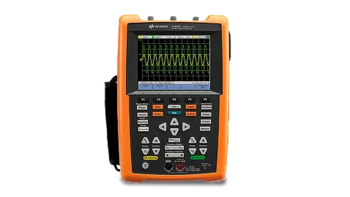
Browse Our Latest Deals of Used Oscilloscopes
Select up to 3 instruments to compare
Enable Notifications
In order to use this feature, you need to enable notifications.
Manage notification preferences
Tapping Into the Potential of Mini Oscilloscopes
Mini oscilloscopes, despite their size, offer an extensive range of features and functionalities. Let's navigate deeper into the diverse applications, notable advantages, and inherent limitations of these compact powerhouses.
Discerning the Ideal Use Cases for Mini Oscilloscopes
The convenience and simplicity of mini oscilloscopes make them an ideal choice for a broad range of applications, particularly where portability and ease of use are paramount.
- Field Diagnostics: Whether you're troubleshooting network installations, conducting environmental testing, or performing maintenance tasks, the mini oscilloscope is your ally. Its lightweight and compact design enables you to carry it easily from one location to another, saving you the hassle of transporting bulkier benchtop oscilloscopes. Its quick setup and user-friendly interface facilitate swift diagnostics and repairs, making it an indispensable tool for field technicians and service engineers.
- Educational Purposes: Mini oscilloscopes are transforming classrooms and laboratories around the world. They provide a cost-effective way for students to gain hands-on experience with signal analysis. Students can observe real-time waveforms and explore various signal characteristics without bearing the hefty costs of a full-sized oscilloscope. The interactive learning that mini oscilloscopes offer aids in deepening students' understanding of electronics principles and practices.
- Hobbyists and DIYers: The world of electronics isn't confined to professionals and students. Many enthusiasts and DIYers are diving into this exciting realm, and mini oscilloscopes are serving as their trusted guide. The affordability of these devices opens the door for enthusiasts to delve deeper into their projects and experiments, whether they're building a homemade radio, designing an LED light show, or troubleshooting a piece of vintage audio equipment. The straightforward operation of mini oscilloscopes allows even beginners to capture and analyze signals without needing a deep understanding of complex electronics principles.
Weighing the Strengths and Limitations of Mini Oscilloscopes
Like any piece of technology, mini oscilloscopes have advantages and limitations. Knowing these features can help you determine if a mini oscilloscope is suitable for the task and how to use it efficiently.
Strengths and Limitations of Mini Oscilloscopes
| Advantages | Limitations |
| High portability | Limited bandwidth and sampling rate compared to benchtop oscilloscopes. |
| Cost-effective | May lack advanced features found in larger oscilloscopes. |
| Ideal for teaching and hobbyist activities | Smaller screens can limit the depth of data visualization. |
Let's delve deeper into these pros and cons.
Advantages:
- High portability: One of the main advantages of mini oscilloscopes is their compact size and lightweight design. You can conveniently slip them into your pocket or bag and take them wherever your work demands. This portability offers flexibility, making mini oscilloscopes particularly beneficial for engineers and technicians who need to carry out field-testing or on-site diagnostics.
- Cost-effectiveness: Mini oscilloscopes are generally less expensive than benchtop oscilloscopes, making them a cost-effective solution for many users. Their affordability does not compromise their ability to deliver the fundamental features necessary for a wide range of testing and troubleshooting tasks.
- Ideal for teaching and hobbyist activities: Given their affordability and user-friendly interface, mini oscilloscopes are a valuable asset for educational settings and hobbyist activities. They offer a practical way for students and enthusiasts to gain hands-on experience in analyzing electronic signals.
Limitations:
- Limited bandwidth and sampling rate: Mini oscilloscopes typically have a lower bandwidth and sampling rate than their benchtop counterparts. While they are more than sufficient for many tasks, these limitations might restrict their use in applications that require high-frequency signal analysis.
- May lack advanced features: Some mini oscilloscopes may not offer the advanced features and functionalities available in larger oscilloscopes, such as advanced triggering options, complex mathematical functions, or extensive memory depth.
- Smaller screens: The compact size of mini oscilloscopes implies a smaller screen size. This might limit the depth of data visualization, making it challenging to observe fine details in complex waveforms.
Understanding these strengths and limitations is crucial in leveraging the full potential of mini oscilloscopes.
Tips for Maximizing the Use of Mini Oscilloscopes
While mini oscilloscopes are user-friendly and straightforward, there are strategies to optimize their use and ensure you get the most accurate and insightful data possible from your signal analysis.
Effective Use of Triggering
Triggering is an essential function of an oscilloscope that helps you stabilize repetitive waveforms and capture non-repetitive events. Here are some tips:
- Choose the right trigger type: Mini oscilloscopes usually offer several types of triggers such as edge, pulse width, and video. Select the one that best suits your signal.
- Set the correct trigger level: The trigger level determines at what point the oscilloscope starts to draw the waveform. Incorrect settings might result in unstable or wrong readings.
Optimize the Sampling Rate
The sampling rate, measured in samples per second (Sa/s), determines how often the oscilloscope takes a measurement. To capture a signal accurately:
- Follow the Nyquist Theorem: This principle suggests that the sampling rate should be at least twice the highest frequency you want to measure. Following this rule can help prevent aliasing, where higher frequency components distort the waveform reconstruction.
- Utilize the maximum sampling rate: Whenever possible, use the maximum sampling rate of your mini oscilloscope to capture as much detail of the signal as possible.
Mastering Waveform Interpretation
Reading and interpreting the waveform correctly is crucial for accurate diagnostics.
- Understand the basics: Ensure you understand the basic properties of waveforms, such as amplitude (the voltage level), frequency (how fast the waveform is changing), and phase (how the waveform is aligned over time).
- Utilize built-in measurements: Many mini oscilloscopes come with built-in automated measurements like peak-to-peak voltage, mean voltage, and frequency. These can save time and improve accuracy.
By mastering these techniques, you can make your mini oscilloscope an even more powerful tool for your signal analysis needs.
Conclusion
Mini oscilloscopes have redefined the boundaries of electronic testing and diagnostics. Mini oscilloscopes offer a cost-effective solution for signal analysis, and provide an excellent learning tool for students. They are a reliable testing tool for hobbyists and professionals alike. Despite their small size, they pack a punch with their operational capabilities, although tasks requiring high-frequency analyses and complex data visualizations may still necessitate larger, benchtop oscilloscopes.
Understanding the specific advantages and limitations of mini oscilloscopes can help you make the most of these devices. Remember, the ultimate choice of oscilloscope, mini or full-sized, depends on your unique needs, the task at hand, and the balance between portability, performance, and price.
If you're interested in exploring the world of oscilloscopes further, we invite you to visit Keysight's Used Equipment Store. Whether you're looking for an affordable mini oscilloscope for on-the-go diagnostics or a full-featured benchtop model for intricate data analysis, Keysight offers a wide array of high-quality used equipment to meet your needs. Start exploring today and uncover the perfect oscilloscope for your next project.

Whenever You’re Ready, Here Are 5 Ways We Can Help You
- Browse our Premium Used Oscilloscopes.
- Call tech support US: +1 800 829-4444
Press #, then 2. Hours: 7 am – 5 pm MT, Mon– Fri - Talk to our sales support team by clicking the icon (bottom right corner) on every offer page
- Create an account to get price alerts and access to exclusive waitlists.
- Talk to your account manager about your specific needs.

Subscribe to Get Our Latest News, Updates, and Articles.
Browse Our Deals of Used Oscilloscopes With Biggest Savings
Select up to 3 instruments to compare
Enable Notifications
In order to use this feature, you need to enable notifications.
Manage notification preferences


